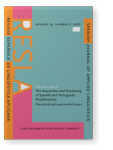Book review
C. Keck & Y. Kim. Pedagogical grammar. Amsterdam/Philadelphia: John Benjamins, 2014. ISBN 978 9027212177 978 9027212184 ix + 245 pp.
References (31)
References
Aljaafreh, A., & Lantolf, J. P. (1994). Negative feedback as regulation and second language learning in the zone of proximal development. The Modern Language Journal, 781, 465–483. 

Biber, D., Johansson, S., & Leech, G. (1999). Longman grammar of spoken and written English. London: Longman.
Boers, F., De Rycker, A., & De Knop, S. (2010). Fostering language teaching efficiency through CL: Introduction. In S. De Knop, F. Boers, & A. De Rycker (eds.), Fostering language teaching efficiency through CL (pp. 1–26). Berlin: Mouton de Gruyter. 

Brown, R. (1973). A first language: The early stages. Cambridge, MA: Harvard University Press. 

Canale, M., & Swain, M. (1980). Theoretical bases of communicative approaches to second language teaching and testing. Applied Linguistics, 11, 1–47. 

Celce-Murcia, M. (1975). English structure in context: An area of research for ESL specialists. Workpapers in teaching English as a second language, Vol. 91. University of California, Los Angeles.
Chomsky, N. (1959). A review of B. F. Skinner’s Verbal Behavior. Language, 351, 26–58. 

Chomsky, N. (1975). Reflections on language. London: Temple Smith.
Corder, P. (1967). The significance of learner’s errors. International Review of Applied Linguistics in Language Teaching, 41, 161–170.
De Knop, S., Boers, F., & De Rycker, T. (eds.). (2010). Fostering language teaching efficiency through cognitive linguistics. Berlin: Mouton de Gruyter. 

De Knop, S., & De Rycker, T. (2008). Cognitive approaches to pedagogical grammar: A volume in honour of René Dirven. Berlin: Mouton de Gruyter. 

Ellis, R. (1993). The structural syllabus and second language acquisition. Tesol Quarterly, 271, 91–113. 

Ellis, N. C., & Larsen-Freeman, D. (2009). Constructing a second language: Analyses and computational simulations of the emergence of linguistic constructions from usage. Language Learning, 59(Suppl. 1), 90–125. 

Hymes, D. H. (1972). On communicative competence. In J. B. Pride & J. Holmes (eds.), Sociolinguistics: Selected Readings, Part 2 (pp. 269–293). New York: Penguin.
Krashen, S. D. (1982). Principles and practice in second language acquisition. Oxford: Pergamon.
Larsen-Freeman, D. (1989). Pedagogical descriptions of language: Grammar. Annual Review of Applied Linguistics, 101, 187–195. 

Larsen-Freeman, D. (2003). Teaching language: From grammar to grammaring. Boston: Heinle/Cengage.
Littlemore, J. (2009). Applying cognitive linguistics to second language learning and teaching. New York: Palgrave Macmillan. 

Long, M. H. (1980). Input, interaction and second language acquisition. Unpublished doctoral dissertation. University of California, Los Angeles.
Long, M. H. (1985). Input and second language acquisition theory. In S. Gass & C. Madden (eds.), Input and second language acquisition (pp. 377–393). Rowley, MA: Newbury House.
McLaughlin, B. (1990). Restructuring. Applied Linguistics, 11(2), 113–128. 

Ortega, L. (2003). Doctoral seminar in SLA: Innovative research on pedagogical grammar. Course Syllabus. English Department, Northern Arizona University.
Schmidt, R. (1990). The role of consciousness in second language learning. Applied Linguistics, 111, 129–158. 

Schmidt, R. (1995). Consciousness and foreign language learning: A tutorial on the role of attention and awareness in learning. In R. Schmidt (ed.), Attention and awareness in foreign language learning (pp. 1–63). Honolulu, HI: University of Hawai’i Press.
Selinker, L. (1972). Interlanguage. International Review of Applied Linguistics, 101, 209–241. 

Sinclair, J. (1987). Looking up: An account of the COBUILD project in lexical computing. London: Collins.
Swain, M. (1985). Communicative competence: Some roles of comprehensible input and comprehensible output in its development. Input in Second Language Acquisition, 151, 165–179.
Wang, W. (2003). How is pedagogical grammar defined in current TESOL training practice? TESL Canada Journal, 21(1), 64–78. 

Wray, A. (2002). Formulaic language and the lexicon. Cambridge: Cambridge University Press. 

